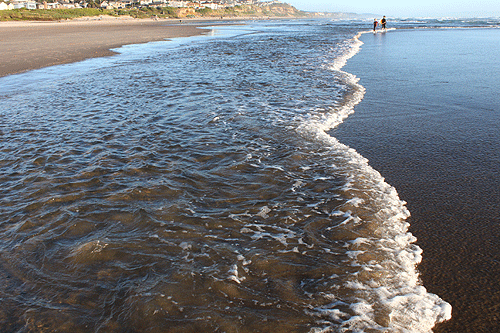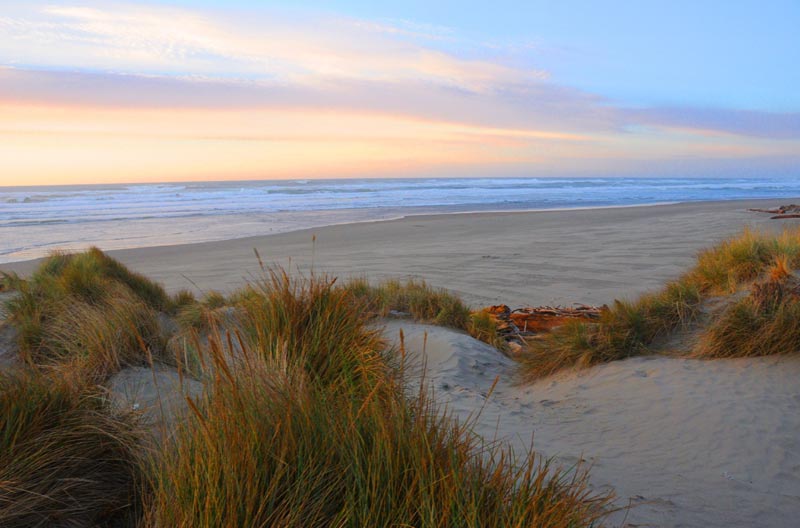Take a Close Look: What's Wrong with This Oregon Coast Wave?
Updated Periodically
By Oregon Coast Beach Connection staff

(Oregon Coast) – Take a close look at this picture of a wave in Lincoln City. Can you spot what's wrong with it?
Hint: notice the direction.
If you guessed the wave is going the wrong way, you're right. It should be coming onto shore – not outgoing. And no, the photo is not altered or flipped.
So what causes this? It's a quirky example of the science of summer on the Oregon coast.
The shot is from Lincoln City's Roads End area, taken in the summer of 2012. It's what can happen when sand levels get extremely high on the beaches, which has been happening more and more each summer in recent years in this region.
Includes exclusive listings; some specials in winter
In Cannon Beach:
Includes rentals not listed anywhere else
In Manzanita, Wheeler, Rockaway Beach:
Some specials for winter
In Pacific City, Oceanside:
Some specials for winter
In Lincoln City:
Some specials for winter
In Depoe Bay, Gleneden Beach:
Some specials for winter
In Newport:
Look for some specials
In Waldport
Some specials for winter
In Yachats, Florence
Some specials for winter
The short answer: sand levels rise so high in summer they create big sand bars on the beaches, which in turn have their own little indentations. If conditions are right and the tides hit these spots just right, the gullies fill up with sea water, and waves can bounce back. They get pushed back out in the direction of the sea, where they just dissipate into the next incoming wave or on the sand bar. .
During summertime, sand levels always rise. Oregon coast geologist Tom Horning said it happens every year to different degrees.
“What you’re seeing is just the usual, seasonal rise in beach elevation because of the summer depositing more sand,” Horning said.
During winter, all that stormy wave action scours out sand. If you have a lot of storms, you can loose ten to twenty feet of the stuff and bedrock shows, along with some startling geological sights that have been hiding under that the whole time.

Above: incoming and outgoing waves "face off"
During summer, the calm wave action brings in more sand. And then with no storm action to take it out, it just keeps building and building.
This backwards wave action can happen anywhere, from the southern Oregon coast up into the northern Washington coast.
At some beaches, the sand piles up incredibly high, causing large sand bars. If you get the right combo of sand bars, low spots and the tide pounding it just right, you'll find this wacky rarity of waves coming back across the sand bar and heading the wrong way.
You can see several photos here of how this happened in Lincoln City that year.
In one shot, you can see the incoming and outgoing waves facing off against each other. In the photo below, you can see where the water pools up.

The other interesting thing is these little wrong way-moving waves are much warmer than the incoming breakers. It feels really good, besides looking so wacky. These are tiny waves, by the way, and will not ever pose a danger. But you still need to keep an eye on sneaker waves from the usual breakers.
Where and when can you find this? It is absolutely impossible to predict. A good guess is that later in summer is your better bet, from July through September, when sand levels really have begun to do incredible things. Look for a kind of broken tidal area: giant pools of water just a bit further inland from the regular breakers, with a high spot of beach and sand between them.
Summer's high sand levels often provide other incredible sights, however. And these are easily found just about everywhere. They create a kind of faux low tide event: meaning sand levels get so high they keep the sea farther out than usual. It's as if there's an extreme low tide, but it's not.

Above: a moving gif showing the wave moving backwards
Other spots to keep an eye on for this:

Bandon, Coos Bay, Meyers Beach, etc. Essentially any long, broad beach on the south coast where sand builds considerably in the summertime can produce this effect. However, even shorter beaches can create this, so simply look for fat, puffy blobs of sand. Stick to later in the summer season, however. Photo above: Horsfall Beach, Coos Bay, courtesy Oregon's Adventure Coast.
Devil's Punchbowl: In recent years, you could actually safely get inside the Punchbowl and the surrounding marine gardens areas.

Arch Cape: Sand levels kept the tide at bay enough so you could go around the point and see the arch that gave the place its name.

Hug Point: also close to Cannon Beach, the tide can get quite a distance from the old road and you can walk around the outside of it. However, the interesting, funky-colored rock structures just below the road are very much covered up.
Labyrinth Beaches Between Yachats and Florence: Places like Strawberry Hill, Bob Creek and Ocean Beach Wayside have plenty of dangerous spots during the rest of the year, but they can be easily explored during such sand level events. Oregon Coast Hotels for this - Where to eat - Maps - Virtual Tours
More About Oregon Coast hotels, lodging.....
More About Oregon Coast Restaurants, Dining.....
LATEST Related Oregon Coast Articles
20 perc off at A1 Vacation Rentals across its roster, including Gleneden Beach. Lincoln City specials
April Gets Even Cheaper Midweek at Depoe Bay, Lincoln City: Oregon Coast Deals
Off-season rates plus more at Keystone Vacation Rentals. Depoe Bay lodging specials, Lincoln City hotel reviews, Newport hotel reviews
Lincoln City Oregon Coast Weather, Alerts, Current Conditions, Cams, Forecast...
Wave height, buoy cam, wind station, data from buoys and ships nearby
Oregon Astronomer: Why Easter Moves Around, April's Meteor Showers
Lyrid meteors, smallest moon of the year, and what's up with Easter. Sciences. south coast events, Florence events, Astoria events, Seaside events, Cannon Beach events, Manzanita events, Rockaway Beach events, Tillamook events, Garibaldi events, Oceanside events, Pacific City events, Lincoln City events, Depoe Bay events, Newport events, Waldport events, Newport events, Yachats events
Famed Washed Ashore Project Will Be New Exhibit at Newport's Oregon Coast Aqu...
The unique exhibit of animals made from debris begins in May. Newport events, Lincoln City events
Oregon Coast Town Celebrates 25 Years of Lincoln City Glass Floats - Special ...
April 26 brings a festival to Taf: what special glass float drops are coming. Lincoln City events
Folk With An Energetic French Accent: Bon Debarras Comes to Central Oregon Co...
Lincoln City Cultural Center on Thursday, April 10. Lincoln City events
Registration Begins for SOLVE Oregon and Coastal Cleanup, April 12 - 22
Help clean coastal beaches, inland natural areas and cities. south coast events, Florence events, Astoria events, Seaside events, Cannon Beach events, Manzanita events, Rockaway Beach events, Tillamook events, Garibaldi events, Oceanside events, Pacific City events, Lincoln City events, Depoe Bay events, Newport events, Waldport events, Newport events, Yachats events
Back to Oregon Coast
Contact Advertise on BeachConnection.net
All Content, unless otherwise attributed, copyright BeachConnection.net Unauthorized use or publication is not permitted



















































